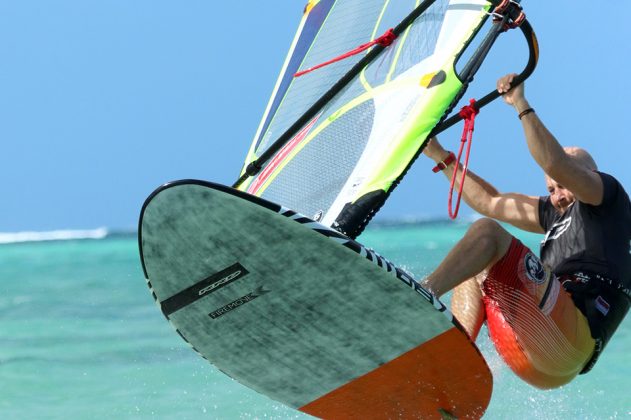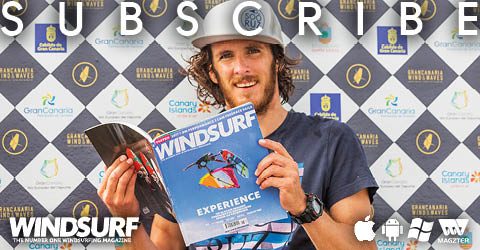JEM HALL
MOVE ON UP – WINDSURFING TECHNIQUE
SQUEEZE – MAKING THE BEST OF FLAT WATER
This article covers how to get the best out of flat water sessions and is relevant for aspiring intermediates, advanced sailors and wave sailors alike. I will cover light winds and planing conditions, and offer different moves for different levels, yet as ever it is up to you to ‘be the pilot and not the passenger.’
Words Jem Hall // Photos Nicolas Jones, Brett Kenny
www.jemhall.com
(This feature originally appeared in the July 2018 issue of Windsurf Magazine. To read more features like this first, Print and Digital subscriptions are available.
Prices include delivery globally for 10 x issues a year!)
LIGHT WINDS
Light winds might be not be our favourite but you have packed your gear and are at the beach and you have a board that floats, so get out there! There’s only so much beach waffle you can talk, and as I say to many clinic groups, and personally hold true, none of us are good enough to not go sailing.
Here are two drills to work on:
• The BOX – this involves sailing upwind over short reaches and doing upwind turns at either end. Then as you reach the edge of your box come back downwind doing gybing moves.
• Performing CIRCLES – sail upwind enough so you can sail back downwind, upwind move after sailing upwind and vice versa on the way back. After doing a few rotations reverse the circle and swap your up and downwind direction.
“ Don’t let the wind do all the work. ”
Moves that Matter
The best moves are essentially anything that mimics our stronger wind physicality and technique and here are some suggestions:
• Leg drags / sailing kneeling down, across the wind.
• Sail one handed, both unhooked and hooked.
• Tack A LOT, and focus on different parts of the move every 5 – 10 attempts.
• Aggressive steering up and downwind, this sharpens up your scissoring and head and hand movements.
• Light wind gybes – this will be covered in a future article, but for now just please do them. And yes you need to own clew first sailing.
• Sail ducking, to help you learn and improve both ducking and sailing clew first.
• Front to sail both ways (sailing backwinded), and then work towards heli tacks.
• Getting in the straps and learning how to be in them whilst non-planing.
• Add other freestyle moves according to your desires / focus / level.
MEDIUM WIND AND BIGGER GEAR
For me at 91 Kilos this would be a 6.5 – 7.0 freeride sail and a 74cm wide (or bigger) freemove board around 110 litres. The physicality of sailing bigger gear and having to actually drive it harder to get it to respond will really give your technique a wake up call. Increased fitness and tougher hands and feet will also be another benefit, not to mention increased time on the water.
Here are the areas to ‘squeeze’:
• Spot gusts and lulls. Use the gusts to anticipate when to work on getting planing. Fly through the lulls by adjusting before they hit you. This is very mentally engaging and proactive!
• Improve all aspects of planing – active planing, lazy pumping and pumping. Tip: arms straight and back leg bent really helps a lot.
• Accelerate and then point as high as possible and do 10 tacks, count them out. Do it early in the sesh or you will always be working on your gybes or returning to the beach for a chat that you do not need to do. Double-digit reps on a move show you mean business.
• Learn to sail off the wind (downwind), consider your body position and rig trim, enjoy it and go fast. All your upwind ‘money in the bank’ has earned you this freedom and exhilaration.
• Sail as fast as you can. Question and feel what it is you need to do to achieve this.
• Gybes – if you are working harder at sailing upwind and tacks then you can try more gybes and can spend more downwind money from all the credit in the upwind bank, so your entrance speed will vastly improve!
• Water start as fast as possible, imagine you are in waves and they will crash down if you don’t get out of the water quick.
• Sail one / no handed whilst planing – front hand, back hand, both off. Let go of any fear that prevents you doing it. These skills will hugely boost your stance, balance, tuning and fitness. It is one of the most important skills that I coach.
• Duck gybes – try them as they are fun and teach us a lot and are actually easier when less powered up.
• Popping the board – learn to do this in a gust, as you are seeing these better now. Who said we learn to jump after gybing? And that we can’t jump on bigger gear.
• Philosophy – build up to double-digit runs in every mini session within your session (hour of power). Many people sail 4 – 6 reaches and then stop, for no apparent reason. Boost your flow and fitness by sailing for longer.
Powered up gybe with planing exit.
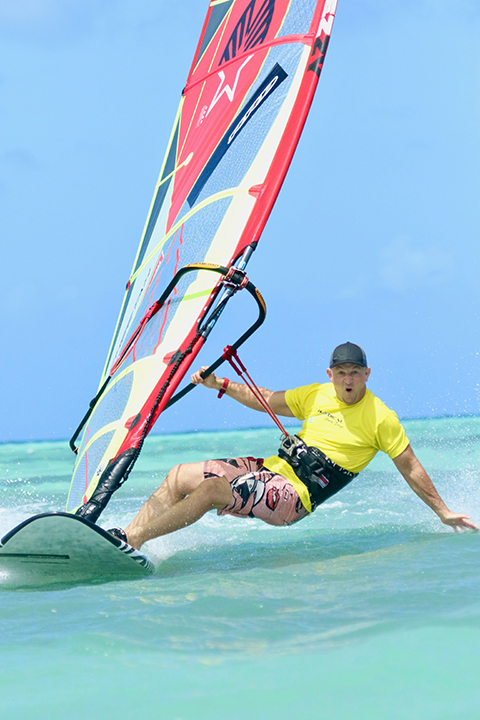
Drop a hand and improve many areas of your sailing. Credit: Brett Kenny
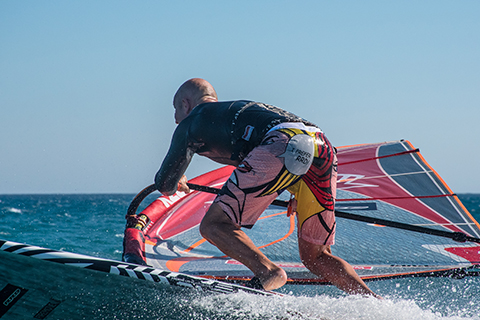
Trying carving 360s really gets you driving forwards dynamically and aggressively. Credit: Nicolas Jones
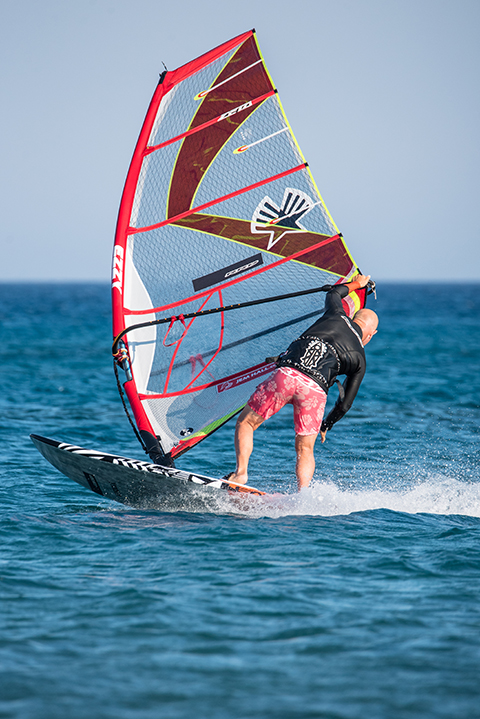
Duck gybes change up your vision and footwork and refresh your skills. Credit: Nicolas Jones
Less powered gybe with non planing exit
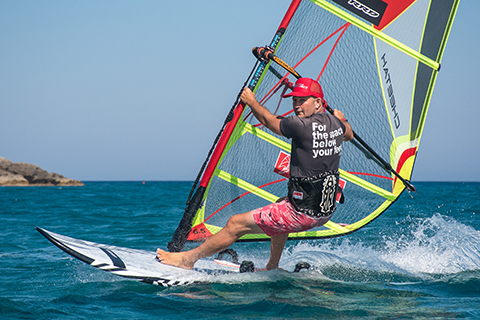
Learning and improving your tacks in flat water will help you in all areas of our sport. Credit: Nicolas Jones
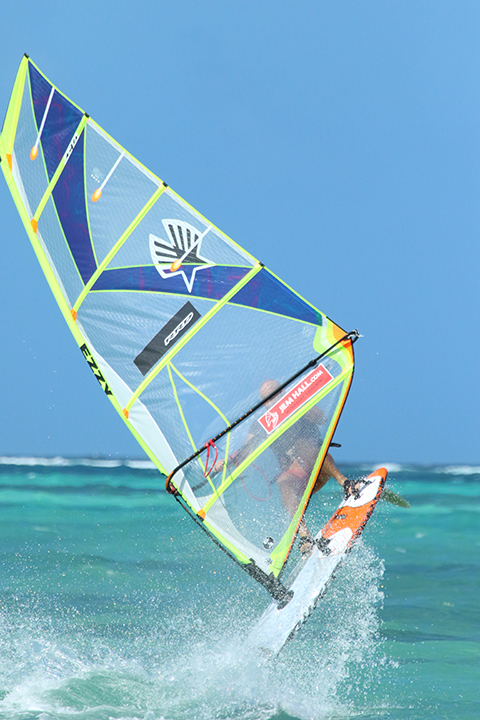
Looping on flat water with bigger kit means you can do many more attempts and teaches you a lot. Credit: Brett Kenny
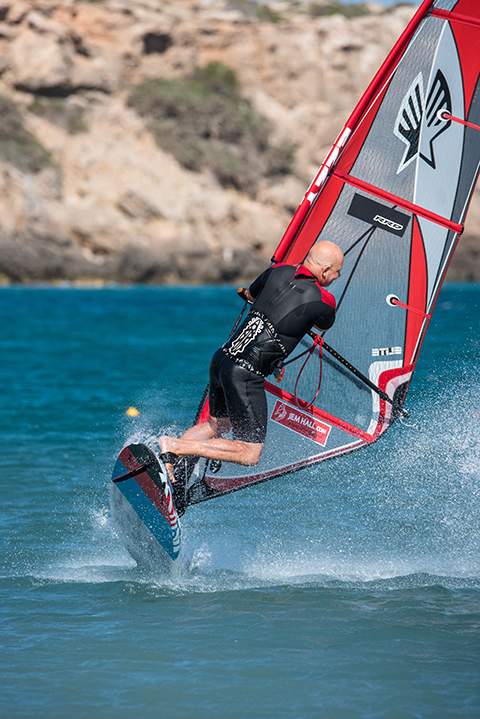
If you really want to mix it up then add in some aerial/sliding freestyle like a Vulcan. Credit: Nicolas Jones
Kit:
Attacking your moves and being aggressive whilst sailing faster will help you appreciate subtle changes that your kit may benefit from.Here are some areas you might want to look at:
• Straps further apart for better popping.
• Faster sailing generates more fin lift and so you can size down your fin and feel higher top end speed, better control in jumps and tighter / more responsive carving.
• Flatter sail to go faster and for more control whilst front to sail in 360s and heli tacks.
HIGH WINDS AND SMALLER GEAR
For advanced sailors/waveheads who think flat water is not for me, it might be worth thinking again, or at least putting the below to the test. My most improved wavesailors have actually added bigger ‘planing’ gear to their quivers with positive results. Squeezing the best out of flat water sessions by following the below will help you mentally and physically for your wave sessions. For those of you who prefer or only have flat water, the following ‘Squeezers’ are awesome for advancement:
• Actively plane, even though it is windy. Get in the straps early and ‘burst out of the blocks’. Don’t let the wind do all the work.
• Accelerate quickly and see how fast, and how high, you can get upwind. Allied to this is doing very short reaches to make you better at the ‘Trinity’ of skills – plane early, sail fast and fly upwind. Plus you will get more moves in!
• Spot your opportunities to do moves, this might be a bump to jump or a flat patch for a gybe, or a kicker for a loop. Even whilst working on your straight-line skills you are best to imagine you are in a skate park.
• Hit the boosters, throw in a couple of high-speed runs and aim to catch someone. You will be amazed how physical sailing faster is. Your control and fitness will be taxed heavily here.
• Chop hops, and two per run, both ways.
• Tail grab jumps. These get you more height and prepare you for loops and stylish moves.
• Duck gybes. As above but now it is about going for it at speed and know that they often yield our first planing exits, HOORAH!
• Carving 360s in the straps.
• Flat water forwards, these are less scary and require good technique and power. Do them.
• Heli tacks, very useful and a massive skill builder.
• Right move, right time. Full power carving and popping moves in gusts / more wind. In less wind, work on tacks and one handed sailing.
• Philosophy – don’t touch the beach, I dare you! Empty your tank, come out of the water like you have been for a good run, or to a circuits class
Location, location, location
Consider your choice of where you sail, it might be worth going somewhere that will help you better achieve your skills. Chop will not help you improve tacks or nail the duck gybe. Once at your spot assess whether the conditions are actually better up or downwind of where you launch from. Some spots may have a higher standard of sailing or more helpful / positive people who facilitate you getting better. One hour in the right spot with good people can be better than 3 hours of monotony, change the record!
RRD boards, wetsuits & softwear, Ezzy Sails & Black Project fins sponsor Jem Hall. Get him live and direct on one of his highly acclaimed coaching holidays but be quick as they are selling out – check out his fab new site www.jemhall.com for details. You can also follow him on twitter / Facebook / Instagram.


